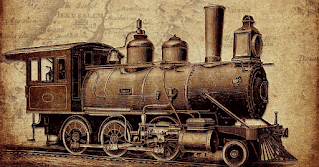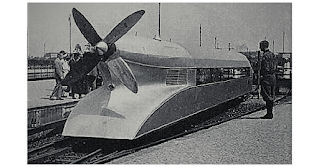Many Railcars were present at the time of the 1920s but modifying an ordinary Railcar into a propeller-driven and adding the engine of the airplane, which is ready to run on the railway track, must be the idea of brilliant Engineers only. Schienenzeppelin was the one modified Railcar.
Further, will be going in-depth about it and how other Railcars were invented later in 1940 taking the idea from Schienenzeppelin.
What is Schienenzeppelin or Rail-zeppelin?
 |
| Schienenzeppelin (Rail-zeppelin) |
Schienenzeppelin or rail zeppelin was an experimental railcar in the appearance of the zeppelin. Zeppelin is a type of rigid airship moving in the sky. Keeping the structure of the zeppelin in the mind.
The structure was made of a train with a look-alike zeppelin and the body of a bullet train, with a hybrid structure of aircraft engine and propeller-driven at the rear end. The Inventor behind making this beautiful invention was Franz Kruckenberg, who was born on August 21, 1882, in Uetersen.
He was a German mechanical engineer and railway designer. He was a pioneer of express rail traffic;
History
 |
| Vintage Railcar |
Back in 1920, when many railroads passed passengers and goods from one country to another. Slowly railways were evolving and with the evolving nature, engineers were trying to change the world with their thoughts and ideas.
In late 1929, One such German aircraft engineer named Franz Kruckenberg decided to add an aircraft engine to a train to create something that resembles like airship on rails. As he was an aircraft engineer, he started designing Zeppelin airship dreaming that would run on the rails. Numerous years were spent on designing it.
He started to put effort into making the body like a bullet-shaped train. When finally the body and the engine were built, this railcar or train (Schienenzeppelin) was propelled with a propeller at the end(rear) of the train. In 1930 it was ready to run on the rails.
This train was named Schienenzeppelin.
About Schienenzeppelin
 |
| Model Schienenzeppelin |
It was invented by German engineer Franz Kruckenberg in the year 1929.
It had the engine of the aircraft and a propeller at the rear end. The body was designed as a bullet train and the material used was aluminum. It had a capacity of 40 passengers.
It broke World railroad speed on 10th May 1931 up till 1954. It had a top speed of 143 mph or 243 km/hr which set a record for gasoline-powered rail engines at that time. Rather other railcars had a speed of 139 mph. It had a height of 2.8m with 28.5m long.
This Schienenzeppelin was only once built and was later scrapped in 1939 due to its risk factors.
Modifications made
Schienenzeppelin was built in 1930 at the time of the Hannover-Leinhausen division of the German Imperial Railway Company. The railcar was modified several times like the original had was powered by two joined BMW IV 6-cylinder gasoline aircraft engines with 4-blade propellers.
But later due to a large crowd was not able to catch this run machine(Schienenzeppelin) it was Increased by changing the engine to a single BMW VI 12-cylinder, with 2 bladed propellers.
How did Schienenzeppelin(Railcar) work?
 |
| The propeller at the rear(end) of the Schienenzeppelin |
The engine provides trust to rear-pointing to a four-blade fixed ash propeller. The shaft attracted to the propeller was raised by 7 degrees from horizontal to provide a downward thrust to push the railcar forward.
Problems faced after some years
One of the most important was concern over its safety. The open propellers were far too dangerous in crowded railway stations.
The engine also had no reverse drive.
Also, the rear-ended propeller was not clear whether it would pull the additional railcar.
Since this revolutionary design would require a massive amount of investment for further modifications. Instead, a new monorail was designed and sent for approval and got approved.
The end of Schienenzeppelin was near
With the small capacity of passengers and concern over the safety and investment in it in the future was too much difficult later in 1939, this Schienenzeppelin was scrapped.
The time was a world war, and the German army also needed material instead of saving it in the museum it would be used for war was the motive.
The engines that had power were cannibalized and fitted to german light bombers. The rest body of the railcar(Schienenzeppelin) was melted down for the german warship.
The invention of further Trains using ideas from Schienenzeppelin
 |
| Aeromotowagon Railcar |
The Aerowagon or Aerowagon was an experimental high-speed railcar fitted with an aircraft engine and propeller traction invented by Valerian Abakovsky.
The aero wagon was originally intended to carry Soviet officials, it produced speeds of up to 140 kilometers per hour (87 miles per hour).
The Aerowagon was a precursor to the German Schienenzeppelin railcar, the American M-497 Black Beetle Railcar, and the Soviet turbojet train, all three of them experimental vehicles featuring the combination of railcar and aircraft engine.
Bullet trains running on the rails was also an idea taken from Schienenzeppelin.
Conclusion
Schienenzeppelin was a great invention but had various factors that had risks in it, which pulled it near failure. Several inventions were made by the inventor Franz Kruckenberg. He later opened his company and started producing vehicles that did not last for a long time.
By far the best invention award was given to Franz Kruckenberg for his invention Schienenzeppelin.








2 comments
👍
ReplyDelete👍
Deletecomment down what do you think?